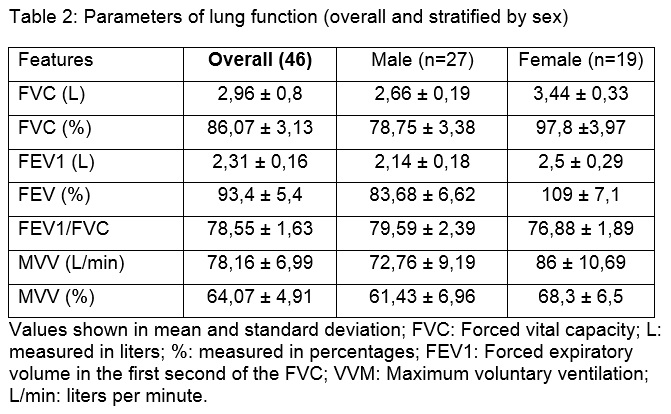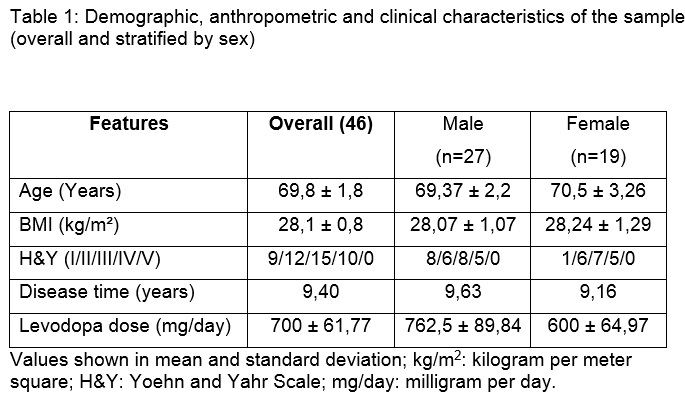Session Information
Date: Monday, September 23, 2019
Session Title: Physical and Occupational Therapy
Session Time: 1:45pm-3:15pm
Location: Les Muses Terrace, Level 3
Objective: Analyse the pulmonary function in patients with PD.
Background: Respiratory disorders are the most common causes of death in people with Parkinson’s disease (PD)(1,2). However, the relationship of PD with respiratory limitations is poorly discussed, with little clinical attention (3), even though the inverse relationship between disease severity (morbidity) and respiratory quality is remarkable (4).
Method: This was a cross-sectional study, approved by the Human Research Ethics Committee of the Federal University of Parana, under the number of 2.200.372, CAAE 66781417.4.0000.0102. Participants were invited to participate in an evaluation of lung function. Inclusion criteria: individuals with a diagnosis of idiopathic PD of both sexes,over 60 years of age, stage I to III of the disease, according to the Hoehn and Yahr scale. Exclusion criteria: smokers (consumption of at least 1 cigarette per week for 6 months), and who had cognitive deficits that impeded the performance of spirometry, as well as associated cardiorespiratory diseases such as asthma, chronic obstructive pulmonary disease (COPD), cystic fibrosis, and heart failure, among others. After inclusion in the study and collection of demographic, anthropometric and clinical data, participants were submitted to pulmonary function evaluation (spirometry) and recorded the following parameters: Forced vital capacity (FVC); Forced expiratory volume in the first second of the FVC (FEV1); FEV1 / FVC ratio and Maximum voluntary ventilation (VVM). All participants were assessed at the “on” phase of the medication by a previously trained physiotherapist.
Results: Participants were 46 individuals, mostly elderly people and males with severity between H & Y II and III (Table 1). Regarding lung function, 14 participants (30.43%) had reduced CVF, 10 (21.74%) presented less than 80% of FEV1 and 7 (15%) had MVV disorder (> 80% of expected), totaling 4 (6.25%) participants with restrictive, 5 (7.8%) with mixed ventilatory disorder and 7 (15%) with reduced ventilatory reserve (Table 2).
Conclusion: In PD there is evidence of respiratory alterations more pronounced than those found in typical aging2, and these are not responsive to the use of the drug3. However, such pulmonary changes may have a good adaptive response to exercise. Physiotherapy can act in the detection, prevention and rehabilitation of ventilatory parameters in PD, being able to reduce morbidity and mortality for this population1.
References: 1- BAILLE, G.; JESUS, A. M.; PEREZ, T.; DEVOS, D.; DUJARDINA, K.; CHARLEY, C. M.; DEFEBVRE, L.; MOREAU, C. Ventilatory Dysfunction in Parkinson’s Disease. Journal of Parkinson’s Disease. n. 6, p. 463–471, 2016. 2- FORSYTH, D.; TORSNEY, K. M. Respiratory dysfunction in Parkinson’s disease. J R Coll Physicians Edinb. v. 47, n.1, p.35-39, 2017. 3 – SECCOMBE, L. M.; GIDDINGS, H. L.; ROGERS, P. G.; CORBETT, A. J.; HAYES, M. W.; PETERS, M. J.; VEITCH, E. M. Abnormal ventilatory control in Parkinson’s disease – further evidence for non-motor dysfunction. Respir Physiol Neurobiol. v. 15, n. 179, p. 300-4, dec., 2011. 4 – WANG Y.; SHAO, W. B.; GAO, L.; LU, J.; GU, H. et al. Abnormal Pulmonary Function and Respiratory Muscle Strength Findings in Chinese Patients with Parkinson’s Disease and Multiple System Atrophy–Comparison with Normal Elderly. PLoS ONE. v.9, n.12, p.e11612, 2014.
To cite this abstract in AMA style:
V. Israel, B. Yamaguchi, M. Ferreira, S. Valderramas. Pulmonary function in patients with Parkinson’s disease [abstract]. Mov Disord. 2019; 34 (suppl 2). https://www.mdsabstracts.org/abstract/pulmonary-function-in-patients-with-parkinsons-disease/. Accessed April 3, 2025.« Back to 2019 International Congress
MDS Abstracts - https://www.mdsabstracts.org/abstract/pulmonary-function-in-patients-with-parkinsons-disease/


